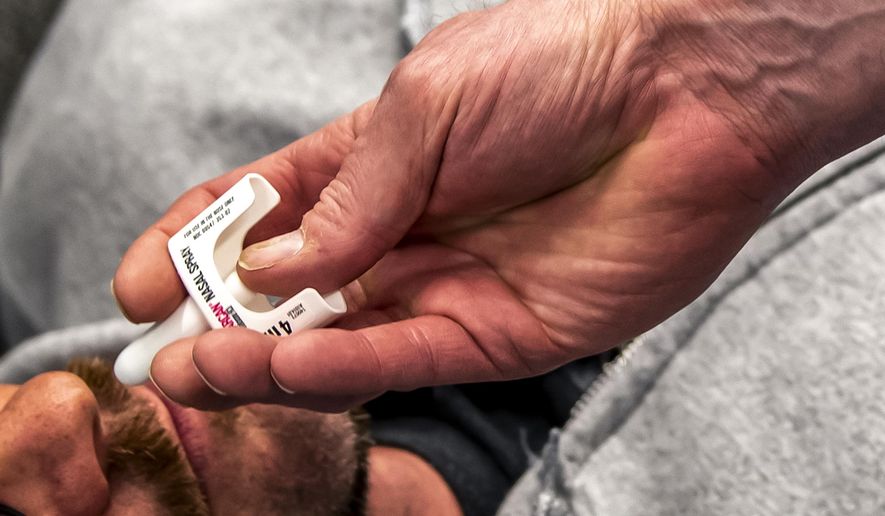A slowdown of fentanyl overdoses led drug-related deaths to level off in 2022 as U.S. mortality rates declined for the first time since before the coronavirus pandemic, according to federal data published Thursday.
In 2022, the nation registered 107,941 drug deaths at a rate of 32.6 overdoses for every 100,000 people, according to one of two reports the CDC’s National Center for Health Statistics released together.
The report noted this rate “did not significantly change” from 106,699 drug deaths or 32.4 overdoses per 100,000 people in 2021. In 2021, the rate jumped by 14% from 91,799 deaths or 28.3 per 100,000 people in 2020.
The CDC previously reported that the U.S. experienced a record-high 30% increase in drug overdose deaths from 2019 to 2020, driven primarily by an uptick in fentanyl abuse amid COVID-19 lockdowns.
In the other report released Thursday, the federal agency found unintentional injuries, including drug overdoses, still overtook COVID as the third-leading cause of death in 2022.
The report said a 57.3% drop in the rate of COVID deaths moved the virus down to the fourth-leading killer of U.S. residents. Heart disease and cancer remained the top two causes, respectively.
Besides poisoning related to drug overdoses, unintentional injuries in the CDC data included car accidents, accidental shootings, fires and drownings.
Statistician Ken Kochanek, a co-author of the mortality report, credited the drop in COVID-19 deaths for driving the age-adjusted death rate for all U.S. residents down by 9.2% from 879.7 deaths for every 100,000 people in 2021 to 798.8 in 2022.
He noted that death rates for heart disease, cancer, diabetes, liver diseases and homicides also fell slightly.
“[It was] mostly the decrease in COVID-19 deaths,” Mr. Kochanek told The Washington Times.
According to the CDC’s final tally, 3,279,857 U.S. residents died in 2022, a drop of 184,374 from 2021. The number of COVID-19 deaths fell from 416,893 to 186,552.
The findings come as fentanyl, a powerful synthetic opioid that depresses the central nervous system, has fueled a decade-long surge in drug overdoses that worsened during COVID restrictions.
In legal form, doctors prescribe fentanyl as a painkiller that is 50 to 100 times more potent than morphine.
The CDC said the death rate from synthetic opioids such as fentanyl, fentanyl analogs and tramadol increased by 4.1% from 2021 to 2022.
The rate of drug overdose deaths per 100,000 people in that category jumped from 11.4 in 2019 to 17.8 in 2020. Between 2021 and 2022, it increased more slowly, from 21.8 to 22.7.
By comparison, the rate of drug overdose deaths involving heroin, a morphine-based natural opioid, plunged by 35.7% from 2.8 per 100,000 people in 2021 to 1.8 in 2022.
Overdose deaths from cocaine increased by 12.3% and those related to psychostimulants such as methamphetamine grew by 4% over the same period. Those rates hit 1.6 and 0.3 deaths per 100,000 people in 2022, respectively.
The CDC said it could not explain the slowdown in drug-related death rates.
Some experts not involved with the studies attributed the slowdown to a fast-changing illegal drug market and the growing effectiveness of public health programs prescribing methadone and buprenorphine to wean people off fentanyl addictions, plus the overdose reversal drug naloxone.
“Heroin is disappearing from the U.S. drug market because it’s being out-competed by fentanyl, which is cheaper and more potent, and that’s why we’re seeing heroin deaths go down,” said psychologist Keith Humphreys, a Stanford University addiction researcher who studies the opioid crisis.
Mr. Humphreys chalked up the slower increase in opioid overdoses partly to the fact that “many people have already died from fentanyl,” creating a shrinking pool of addicts.
Sheila P. Vakharia, deputy director at the Drug Policy Alliance, a New York-based group that opposes banning addictive substances, pointed to research showing that “expanded access to methadone and buprenorphine can cut the risk of fatal overdose in half for patients.”
“Harm reduction programs where people can get access to sterile drug equipment, naloxone, and referrals to services can also be a lifeline in these communities,” Ms. Vakharia said in an email.
Local, state and federal officials have spent millions of dollars on these treatments.
Last week, the Biden administration announced an initiative to promote naloxone, a nasal spray often sold under the brand name Narcan.
The Food and Drug Administration approved Narcan spray for over-the-counter use in March 2023 and a generic version last July.
Kenneth Feder, a drug overdose researcher in the Department of Mental Health at Johns Hopkins Bloomberg School of Public Health, cautioned that the opioid death tally in 2022 “remained higher than at any prior year on record” despite the proven effectiveness of such treatments.
“We need to make sure that naloxone is easily available to people who use drugs,” Mr. Feder said. “Bystanders and first responders can use naloxone to reverse an opioid overdose and save a life.”
According to the data released Thursday, 73,838 people died from overdoses related to non-methadone synthetic opioids such as fentanyl in 2022, up from 70,601 deaths in 2021 and 28,466 in 2017.
The CDC found 5,871 people died from heroin overdoses nationwide in 2022, down from 9,173 in 2021 and 15,482 in 2017.
Timothy Jansen, CEO of Community Crisis Services, a 988 call center in Hyattsville, Maryland, urged addicts and family members to call the national lifeline for help before reaching the point of overdose.
“We connect folks with a variety of services for substance abuse including treatment, assessment, counseling, etc.,” said Mr. Jansen, a veteran crisis counselor. “Resources include private, public and faith-based options where available.”
• Sean Salai can be reached at ssalai@washingtontimes.com.




Please read our comment policy before commenting.